Effects of Anthropogenic Aerosols on a Heavy Rainstorm in Beijing
Abstract
1. Introduction
2. The Precipitation Event
3. Model Setup and Experimental Design
3.1. Model Setup
3.2. Experimental Design
4. Results Analyses
4.1. Comparison of PM2.5 Concentrations
4.2. Effects of Aerosols on Precipitation
4.3. Effects of Aerosols on Microphysical Processes
4.4. Effects of Aerosols on Vertical Velocity
5. Conclusions
- (1)
- During this rainfall process, Beijing was located at the entrance of the upper-level jet stream on 20 July 2016. During the westward and northward movement of the subtropical high, the cold vortex moved slowly, and this movement enabled the low-pressure system to be maintained for a long time in North China. Simultaneously, water vapor from the Bay of Bengal was transported to the North China area, providing good conditions for this rainfall process.
- (2)
- When the anthropogenic emission was increased by 10 times, the area average accumulated rainfall amount and the maximum accumulated rainfall amount decreased by 9% and 5.4%, respectively. When the anthropogenic emission decreased to 10%, the area-average accumulated rainfall amount and the maximum accumulated rainfall amount increased by 8% and 4%, respectively. In the clean test, the area of accumulated rainfall amounts greater than 25 mm in the Beijing area was 10% larger than that of the other two tests.
- (3)
- With the increase in anthropogenic emissions, the concentration of aerosols increased. Thus, the number concentrations of CCN and cloud droplets increased, which led to an increase in the cloud water mixing ratio. Because the radii of cloud droplets decreased, the contact area between the cloud and rain was reduced, and the collision process was decreased. The autoconversion rate of cloud water into rain was low for small cloud droplets. In the clean test, the collision efficiency and autoconversion rate of cloud water into rain were high for large contact areas and large cloud droplets.
- (4)
- In the clean test, the graupel mixing ratio was the largest. Thus, the process of melting of graupel into rain was the largest.
- (5)
- The mixing ratios of snow and ice did not show too many differences among the three tests. In the WRF-Chem model, the aerosols cannot participate in the ice-phase microphysical processes as IN. For the main formation process of deposition of water vapor into ice was not changed, there was no change in ice mixing ratio. The main formation processes of snow were related to ice. Therefore, there was no change in snow mixing ratio. The concentration variation mainly influenced the warm rain processes and mix-phased processes near the freezing level line.
Author Contributions
Funding
Conflicts of Interest
References
- Gong, W.; Zhang, T.H.; Zhu, Z.; Ma, Y.; Ma, X.; Wang, W. Characteristics of PM1.0, PM2.5, and PM10, and Their Relation to Black Carbon in Wuhan, Central China. Atmosphere 2015, 6, 1377–1387. [Google Scholar] [CrossRef]
- Han, R.; Wang, S.; Shen, W.; Wang, J.; Wu, K.; Ren, Z.; Feng, M. Spatial and temporal variation of haze in China from 1961 to 2012. J. Environ. Sci. 2016, 46, 134–146. [Google Scholar] [CrossRef] [PubMed]
- Zhang, J.; Liu, Y.; Cui, L.; Liu, S.; Yin, X.; Li, H. Ambient air pollution, smog episodes and mortality in Jinan, China. Sci. Rep. 2017, 7, 11209. [Google Scholar] [CrossRef]
- Lang, J.; Li, S.; Cheng, S.; Zhou, Y.; Chen, D.; Zhang, Y.; Zhang, H.; Wang, H. Chemical Characteristics and Sources of Submicron Particles in a City with Heavy Pollution in China. Atmosphere 2018, 9, 388. [Google Scholar] [CrossRef]
- Chalvatzaki, E.; Chatoutsidou, S.E.; Lehtomäki, H.; Almeida, S.M.; Eleftheriadis, K.; Hänninen, O.; Lazaridis, M. Characterization of Human Health Risks from Particulate Air Pollution in Selected European Cities. Atmosphere 2019, 10, 96. [Google Scholar] [CrossRef]
- Lu, H.; Wu, Y.; Mutuku, J.; Chang, K.H. Various Sources of PM2.5 and their Impact on the Air Quality in Tainan City, Taiwan. Aerosol. Air Qual. Res. 2019, 19, 601–619. [Google Scholar] [CrossRef]
- Kiehl, J.; Briegleb, B. The relative roles of sulfate aerosols and greenhouse gases in climate forcing. Science 1993, 260, 311–314. [Google Scholar] [CrossRef]
- Koren, I.; Kaufman, Y.; Remer, L.; Martins, J. Measurement of the effect of Amazon smoke on inhibition of cloud formation. Science 2004, 303, 1342–1345. [Google Scholar] [CrossRef] [PubMed]
- Boucher, O.; Randall, D.; Artaxo, P. Clouds and aerosols. In Climate Change 2013: The Physical Science Basis: Contribution of Working Group I to the Fifth Assessment Report of the Intergovernmental Panel on Climate Change; Cambridge University Press: Cambridge, UK; New York, NY, USA, 2013; pp. 571–657. [Google Scholar]
- Castellanos, P.; Da Silva, A.M.; Darmenov, A.S.; Buchard, V.; Govindaraju, R.; Ciren, P.; Kondragunta, S. A Geostationary Instrument Simulator for Aerosol Observing System Simulation Experiments. Atmosphere 2019, 10, 2. [Google Scholar] [CrossRef]
- Phillips, V.; Andronache, C.; Sherwood, S.; Bansemer, A.; Conant, W.C.; Demott, P.J.; Flagan, R.C.; Heymsfield, A.; Jonsson, H.; Poellot, M.; et al. Anvil glaciation in a deep cumulus updraught over Florida simulated with the Explicit Microphysics Model. I: Impact of various nucleation processes. Q. J. R. Meteorol. Soc. 2005, 131, 2019–2046. [Google Scholar] [CrossRef]
- Zhang, R.; Li, G.; Fan, J.; Wu, D.; Molina, M. Intensification of Pacific storm track linked to Asian pollution. Proc. Natl. Acad. Sci. USA 2007, 104, 5295–5299. [Google Scholar] [CrossRef] [PubMed]
- Rosenfeld, D.; Lohmann, U.; Raga, G.; O’Dowd, C.; Kulmala, M.; Fuzzi, S.; Reissell, A.; Andreae, M. Flood or drought: How do aerosols affect precipitation? Science 2008, 321, 1309–1313. [Google Scholar] [CrossRef]
- Fan, J.; Comstock, J.; Ovchinnikov, M. The cloud condensation nuclei and ice nuclei effects on tropical anvil characteristics and water vapor of the tropical tropopause layer. Environ. Res. Lett. 2010, 5, 044005. [Google Scholar] [CrossRef]
- Tuccella, P.; Menut, L.; Briant, R.; Deroubaix, A.; Khvorostyanov, D.; Mailler, S.; Siour, G.; Turquety, S. Implementation of Aerosol-Cloud Interaction within WRF-CHIMERE Online Coupled Model: Evaluation and Investigation of the Indirect Radiative Effect from Anthropogenic Emission Reduction on the Benelux Union. Atmosphere 2019, 10, 20. [Google Scholar] [CrossRef]
- Varghese, M.; Prabha, T.; Murugavel, P. Aerosol and cloud droplet characteristics over Ganges Valley during break phase of monsoon: A case study. Atmos. Res. 2019, 220, 125–140. [Google Scholar] [CrossRef]
- Twomey, S. The influence of pollution on the shortwave albedo of clouds. J. Atmos Sci. 1977, 34, 1149–1152. [Google Scholar] [CrossRef]
- Fan, J.; Leung, L.; Rosenfeld, D.; Chen, Q.; Li, Z.; Zhang, J.; Yan, H. Microphysical Effects Determine Macrophysical Response for Aerosol Impacts on Deep Convective Clouds. Proc. Natl. Acad. Sci. USA 2013, 110, E4581–E4590. [Google Scholar] [CrossRef] [PubMed]
- Zhong, S.; Qian, Y.; Zhao, C.; Leung, R.; Wang, H.; Yang, B.; Fan, J.; Yan, H.; Yang, X.; Liu, D. Urbanization-induced urban heat island and aerosol effects on climate extremes in the Yangtze River Delta region of China. Atmos. Chem. Phys. 2017, 17, 5439–5457. [Google Scholar] [CrossRef]
- Yang, H.; Xiao, H.; Hong, Y. Progress in impacts of aerosol on cloud properties and precipitation. Clim. Environ. Res. 2011, 16, 525–542. [Google Scholar]
- IPCC. Summary for policymakers. In Climate Change 2013: The Physical Science Basis. Contribution of Working Group I to the Fifth Assessment Report of the Intergovernmental Panel on Climate Change; Cambridge University Press: Cambridge, UK; New York, NY, USA, 2013; pp. 3–29. [Google Scholar]
- Várnai, T.; Marshak, A. Satellite Observations of Cloud-Related Variations in Aerosol Properties. Atmosphere 2018, 9, 430. [Google Scholar] [CrossRef]
- Hobbs, P. Aerosol-Cloud-Climate Interactions; Academic Press: Cambridge, MA, USA, 1993; p. 54. [Google Scholar]
- McComiskey, A.; Feingold, G. The scale problem in quantifying aerosol indirect effects. Atmos. Chem. Phys. 2012, 12, 1031–1049. [Google Scholar] [CrossRef]
- Fan, J.; Wang, Y.; Rosenfeld, D.; Liu, X. Review of aerosol–cloud interactions: Mechanisms, significance, and challenges. J. Atmos Sci. 2016, 73, 4221–4252. [Google Scholar] [CrossRef]
- Shepherd, J.; Burian, S. Detection of urban-induced rainfall anomalies in a major coastal city. Earth Interact. 2003, 7, 1–17. [Google Scholar] [CrossRef]
- Mashayekhi, R.; Sloan, J. Effects of aerosols on precipitation in north-eastern North America. Atmos. Chem. Phys. 2014, 14, 5111–5125. [Google Scholar] [CrossRef]
- Lacke, M.; Mote, T.; Shepherd, J. Aerosols and associated precipitation patterns in Atlanta. Atmos. Environ. 2009, 43, 4359–4373. [Google Scholar] [CrossRef]
- Evan, A.; Foltz, G.; Zhang, D.; Vimont, D. Influence of African dust on ocean–atmosphere variability in the tropical Atlantic. Nat. Geosci. 2011, 4, 762–765. [Google Scholar] [CrossRef]
- Rosenfeld, D. TRMM observed first direct evidence of smoke from forest fires inhibiting rainfall. Geophys. Res. Lett. 1999, 26, 3105–3108. [Google Scholar] [CrossRef]
- Xiao, H.; Yin, Y.; Jin, L.; Chen, Q.; Chen, J. Simulation of aerosol effects on orographic clouds and precipitation using WRF model with a detailed bin microphysics scheme. Atmos. Sci. Lett. 2014, 15, 134–139. [Google Scholar] [CrossRef]
- Borys, D.; Lowenthal, D.; Cohn, S.; Brown, W. Mountain top and radar measurements of anthropogenic aerosol effects on snow growth and snowfall rate. Geophys. Res. Lett. 2003, 30, 1538. [Google Scholar] [CrossRef]
- Givati, A.; Rosenfeld, D. Quantifying precipitation suppression due to air pollution. J. Appl. Meteorol. 2004, 43, 1038–1056. [Google Scholar] [CrossRef]
- Yang, H.; Xiao, H.; Hong, Y. The effects of giant cloud condensation nuclei on the structure of precipitation in hailstorm clouds. Sci China Earth Sci. 2012, 55, 126–142. [Google Scholar] [CrossRef]
- Yang, H.; Xiao, H.; Hong, Y. A numerical study of aerosol effects on cloud microphysical processes of hailstorm clouds. Atmos. Res. 2011, 102, 432–443. [Google Scholar] [CrossRef]
- Jiang, B.; Huang, B.; Lin, W.; Xu, S. Investigation of the effects of anthropogenic pollution on typhoon precipitation and microphysical processes using WRF-Chem. J. Atmos. Sci. 2016, 73, 1593–1610. [Google Scholar] [CrossRef]
- Gibbons, M.; Min, Q.; Fan, J. Investigating the impacts of Saharan dust on tropical deep convection using spectral bin microphysics. Atmos. Chem. Phys. 2018, 18, 12161–12184. [Google Scholar] [CrossRef]
- Fan, J.; Rosenfeld, D.; Ding, Y.; Leung, L.; Li, Z. Potential aerosol indirect effects on atmospheric circulation and radiative forcing through deep convection. Geophys. Res. Lett. 2012, 39, L09806. [Google Scholar] [CrossRef]
- Ilotoviz, E.; Khain, A. Application of a new scheme of cloud base droplet nucleation in a spectral (bin) microphysics cloud model: Sensitivity to aerosol size distribution. Atmos. Chem. Phys. 2016, 16, 14317–14329. [Google Scholar] [CrossRef]
- Dagan, G.; Koren, I.; Altaratz, O. Aerosol effects on the timing of warm rain processes. Geophys. Res. Lett. 2015, 42, 4590–4598. [Google Scholar] [CrossRef]
- Wu, R. Principles of Modern Meteorology; Higher Education Press: Beijing, China, 1999; p. 319. [Google Scholar]
- Hong, S.; Pan, H. Nonlocal boundary layer vertical diffusion in a medium-range forecast model. Mon. Weather Rev. 1996, 124, 2322–2339. [Google Scholar] [CrossRef]
- Iacono, M.; Delamere, J.; Mlawer, E.; Shephard, M.; Clough, S.; Collins, W. Radiative forcing by long-lived greenhouse gases: Calculations with the AER radiative transfer models. J. Geophys. Res. 2008, 113, D13103. [Google Scholar] [CrossRef]
- Chen, F.; Dudhia, J. Coupling an advanced land surface hydrology model with the Penn State-NCAR MM5 modeling system. Part I: Model implementation and sensitivity. Mon. Weather Rev. 2001, 129, 569–585. [Google Scholar] [CrossRef]
- Morrison, H.; Curry, J.; Khvorostyanov, V. A new double-moment microphysics parameterization for application in cloud and climate models. Part I: Description. J. Atmos. Sci. 2005, 62, 1665–1677. [Google Scholar] [CrossRef]
- Zaveri, R.; Peters, L. A new lumped structure photochemical mechanism for large-scale applications. J. Geophys. Res. 1999, 104, 30387–30415. [Google Scholar] [CrossRef]
- Fast, J.; Gustafson, W.; Easter, R.; Zaveri, R.; Barnard, J.; Chapman, E.; Grell, G.; Peckham, S. Evolution of ozone, particulates, and aerosol direct radiative forcing in the vicinity of Houston using a fully coupled meteorology-chemistry-aerosol model. J. Geophys. Res. 2006, 111, D21305. [Google Scholar] [CrossRef]

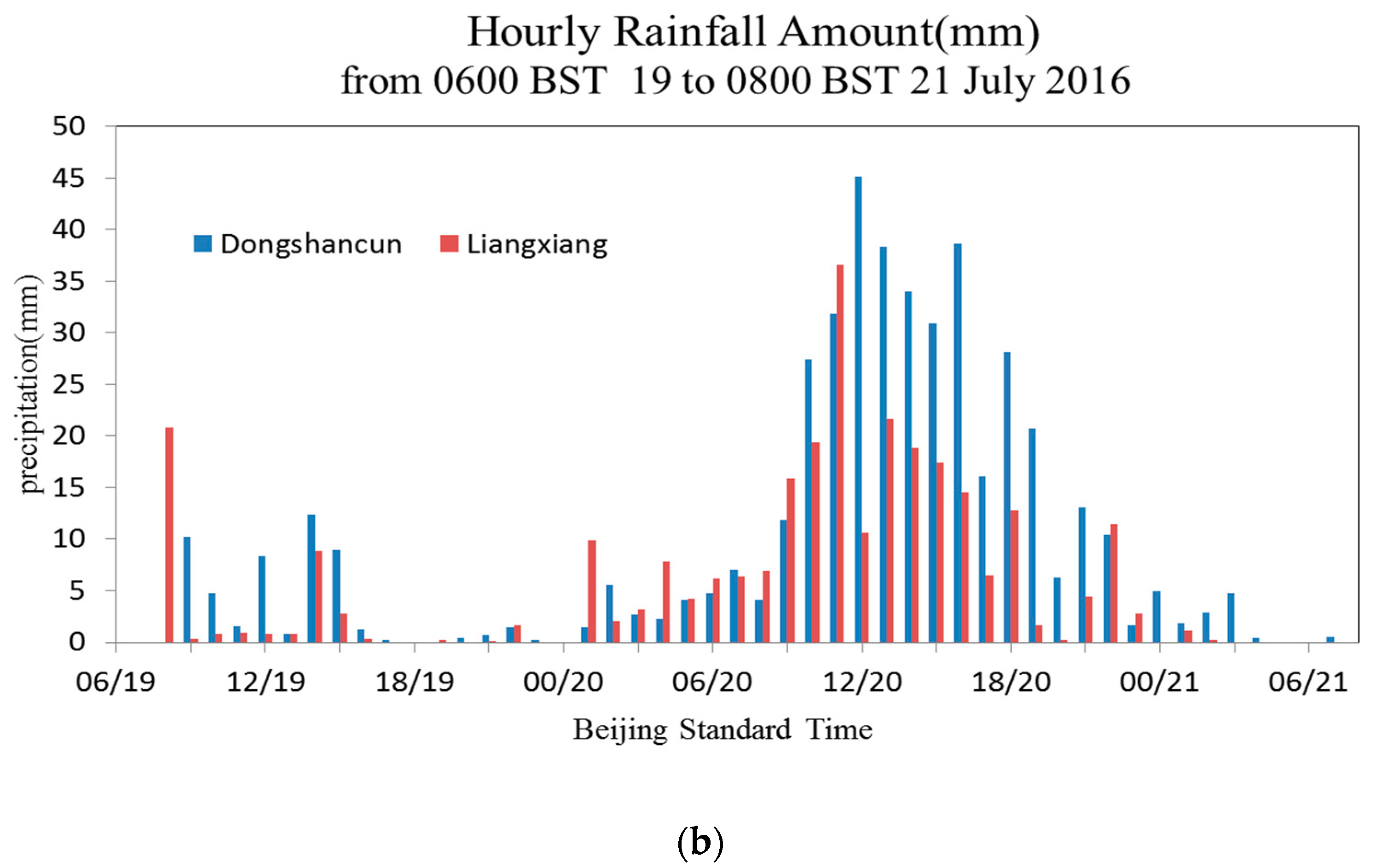
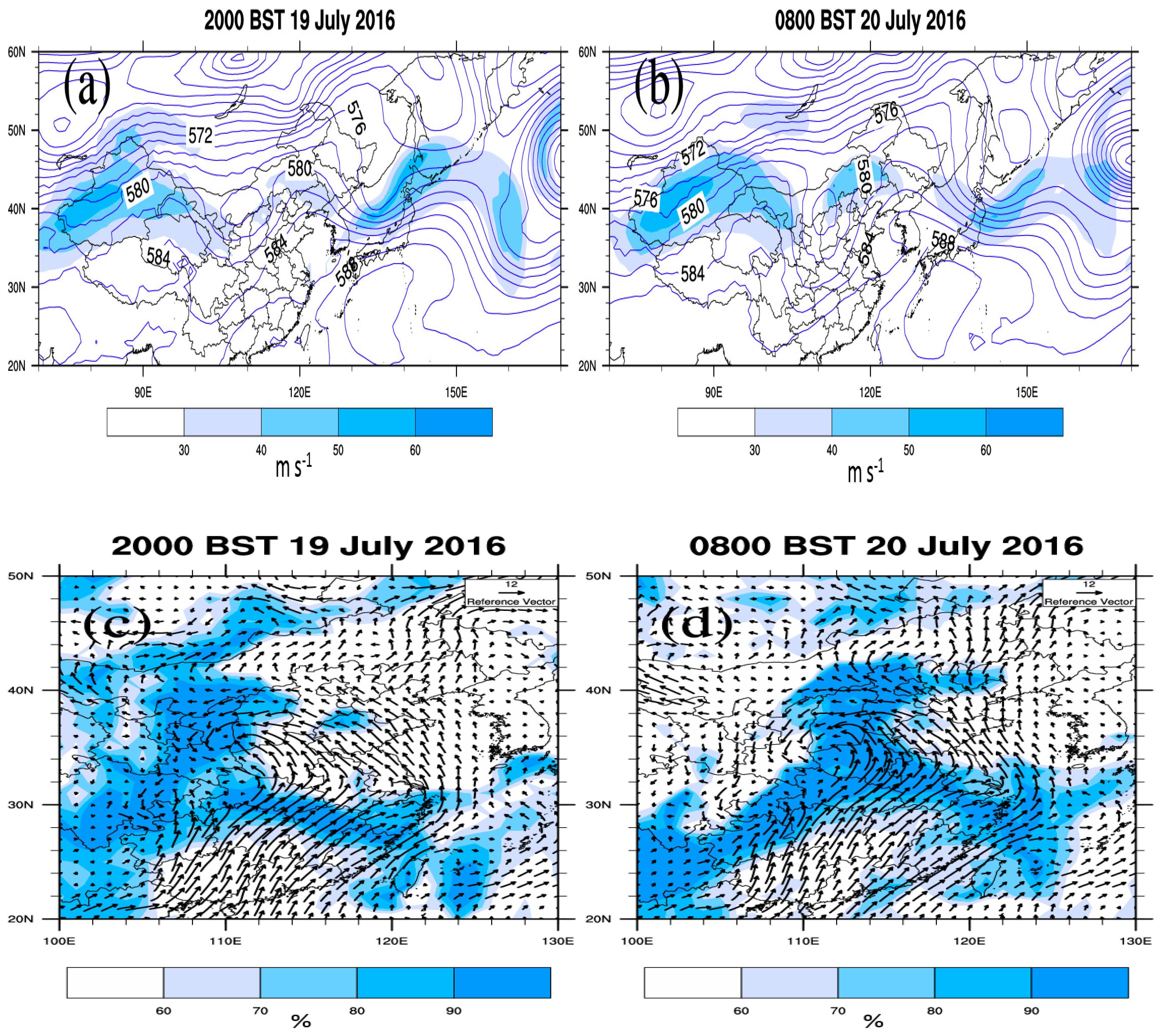
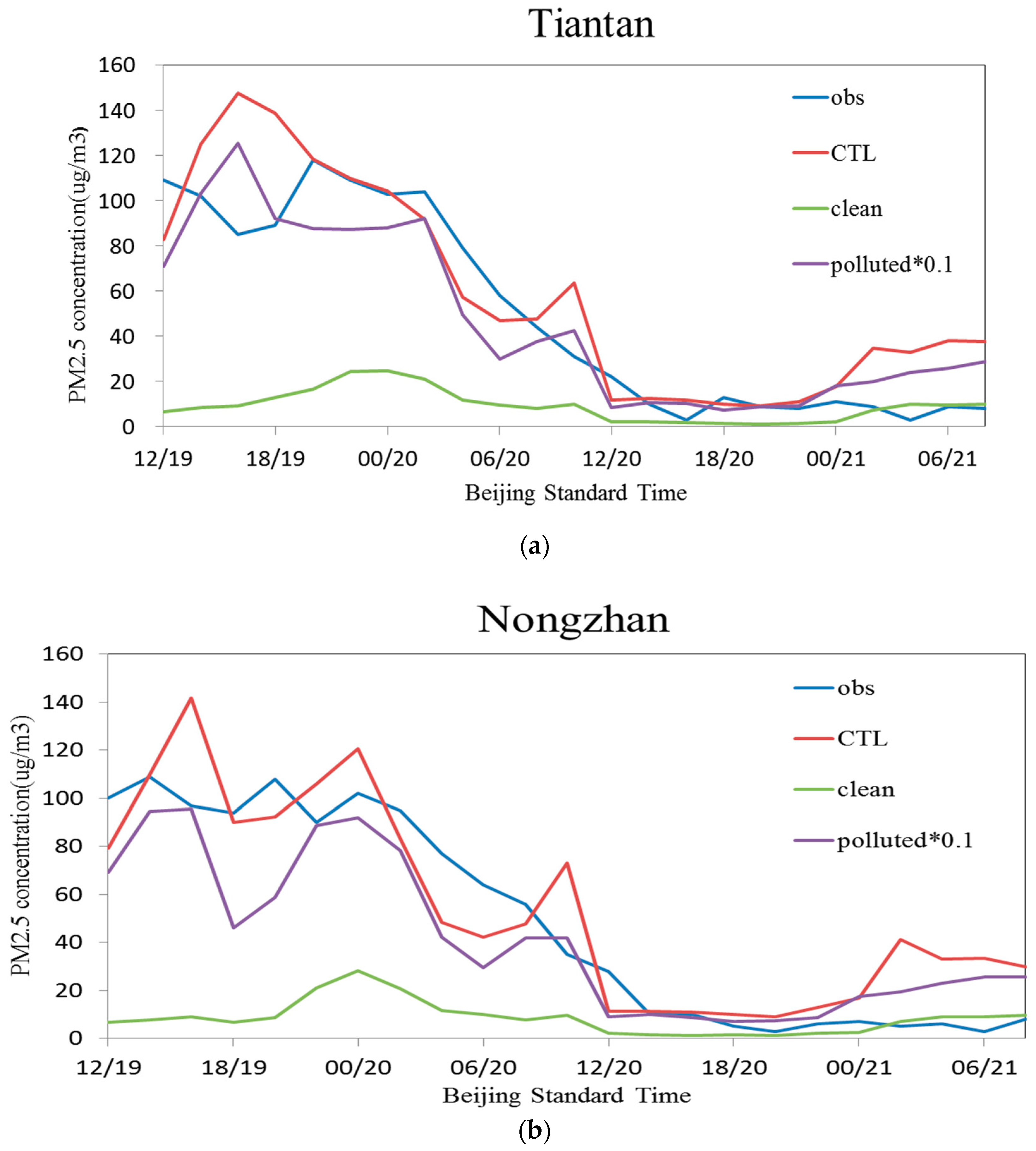
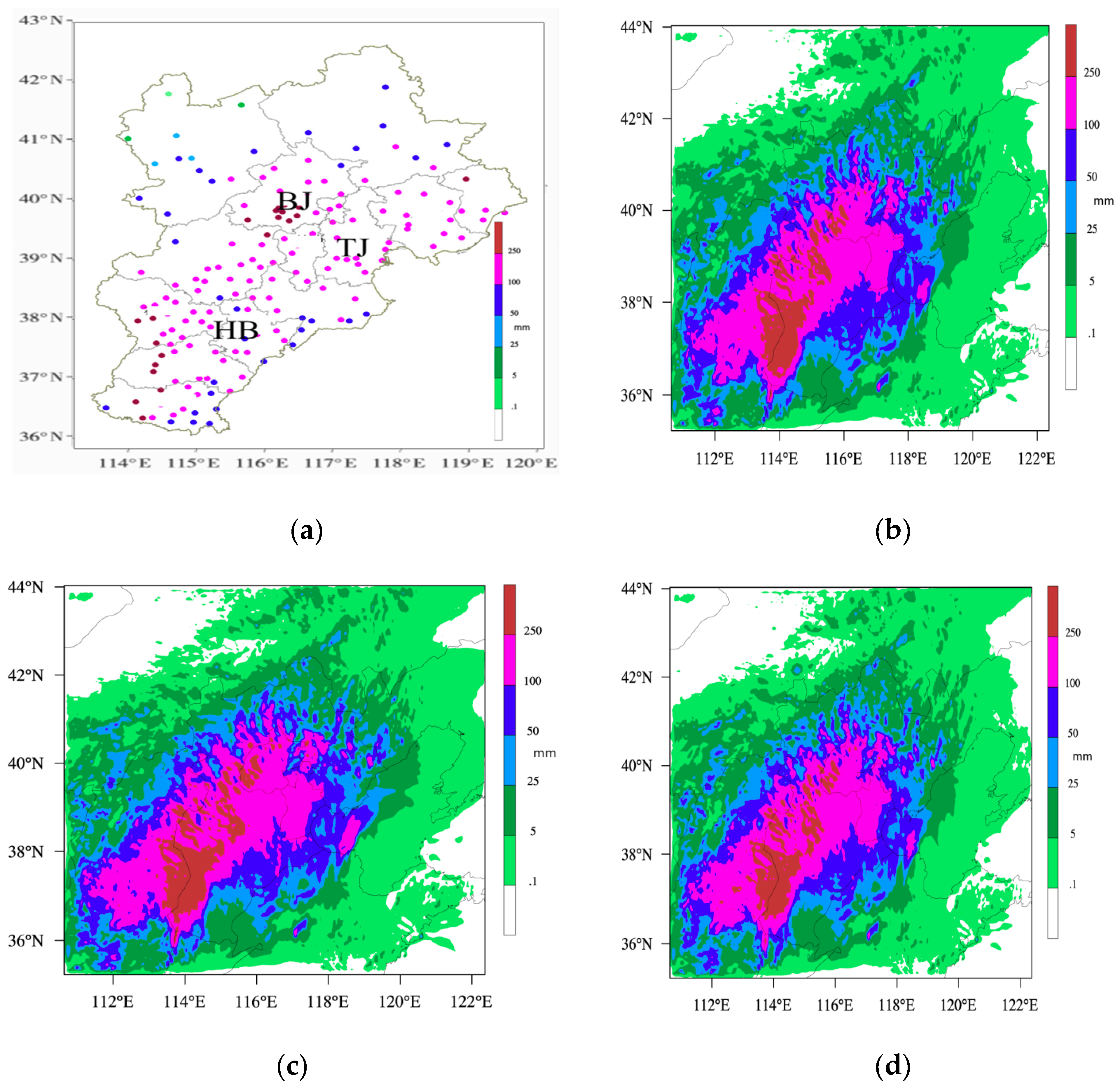
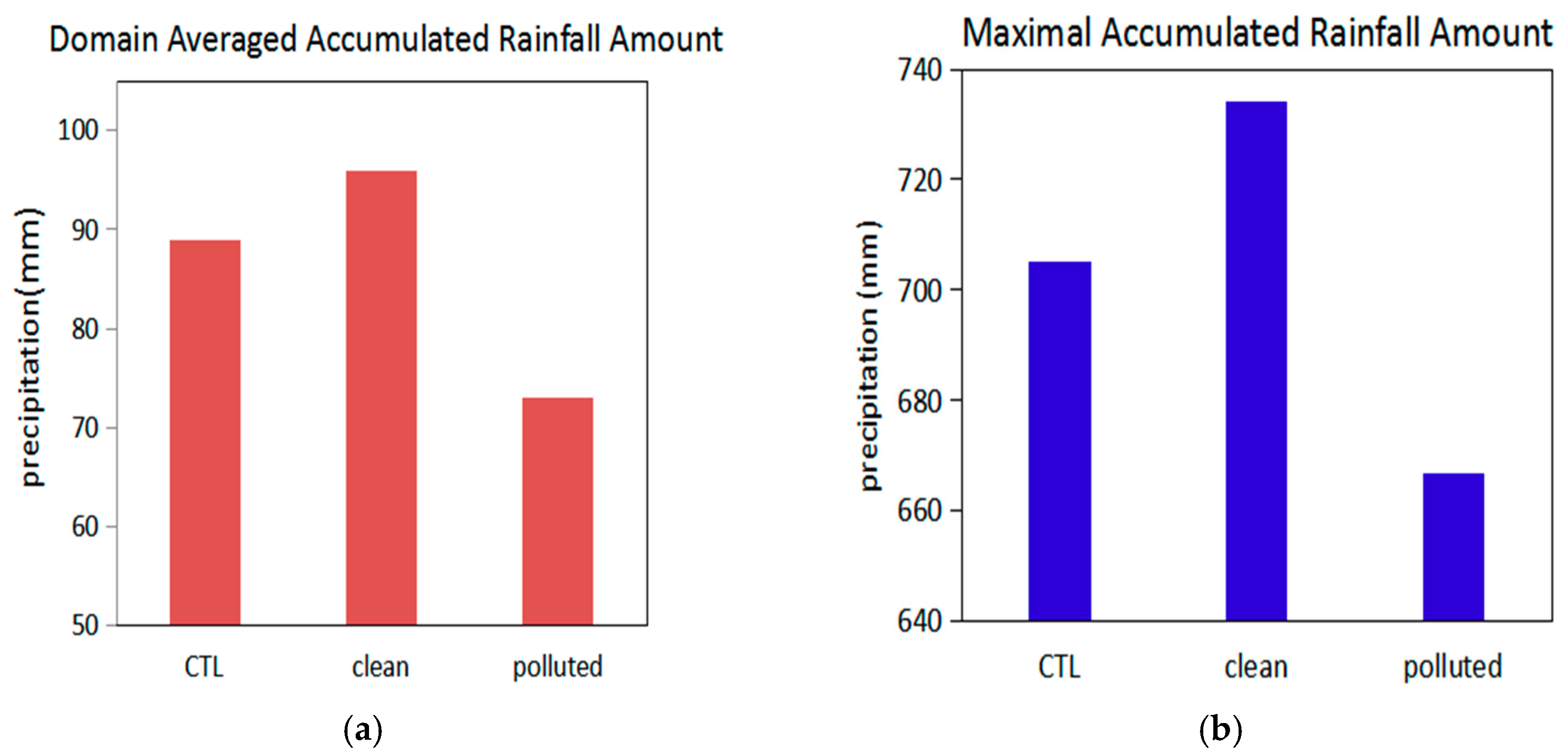
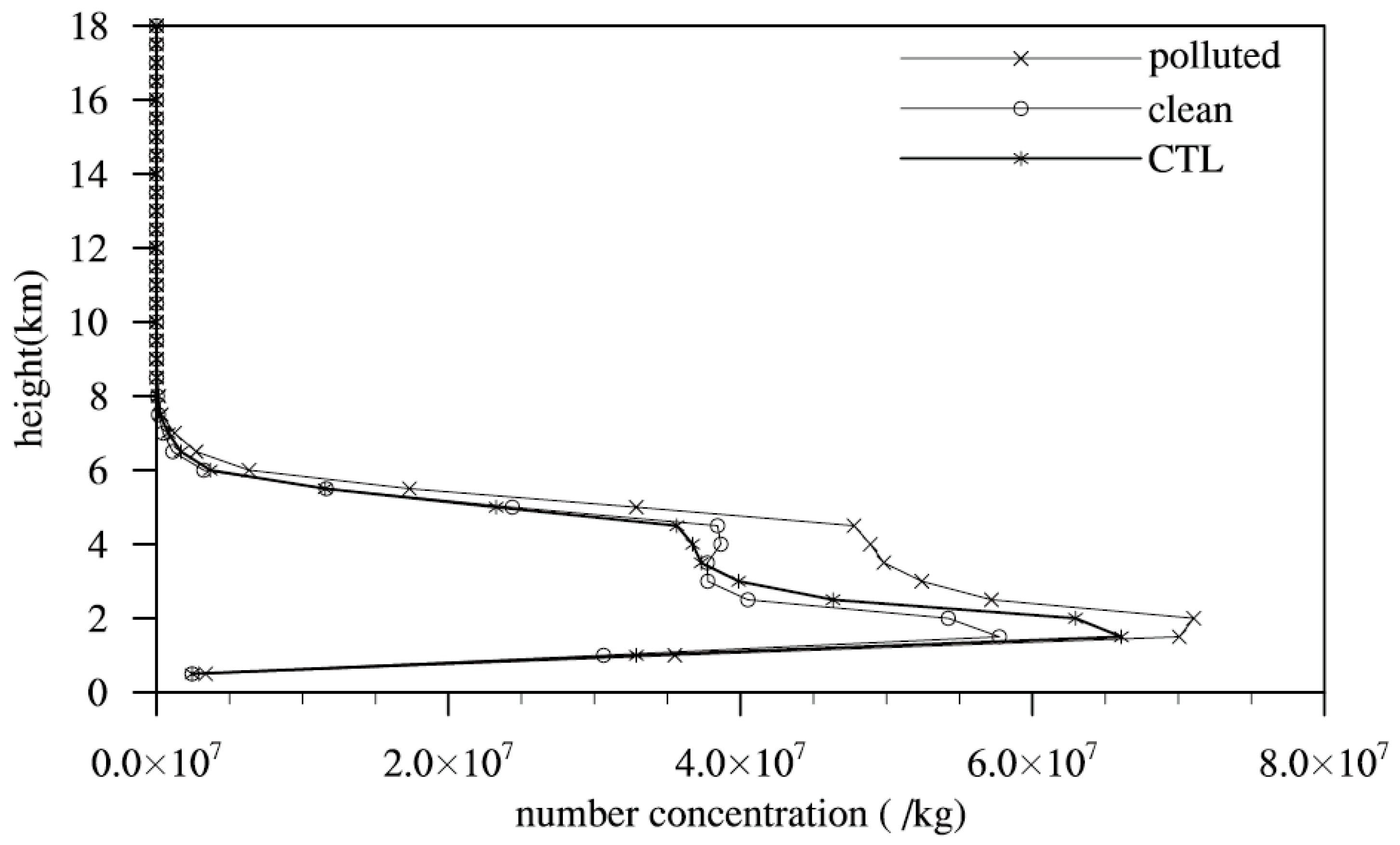
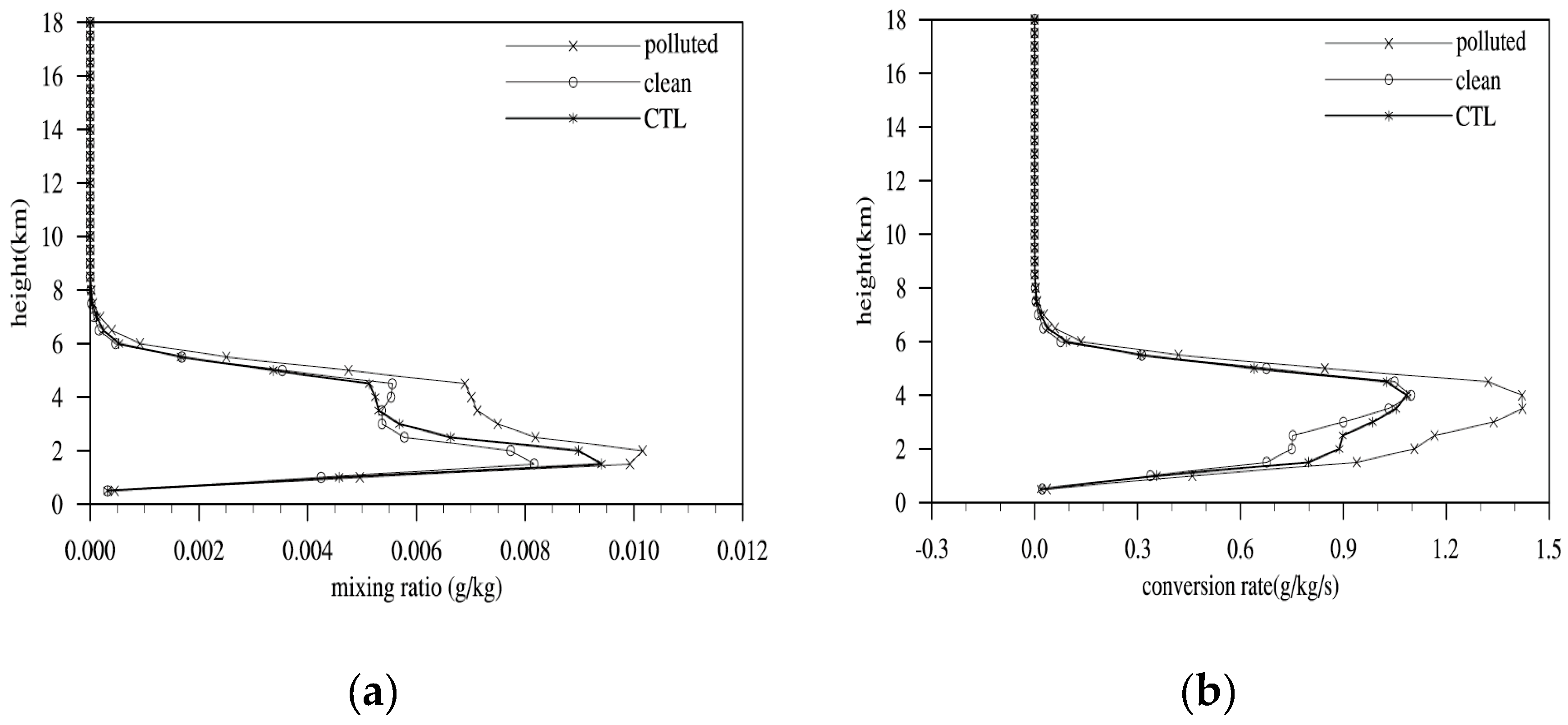
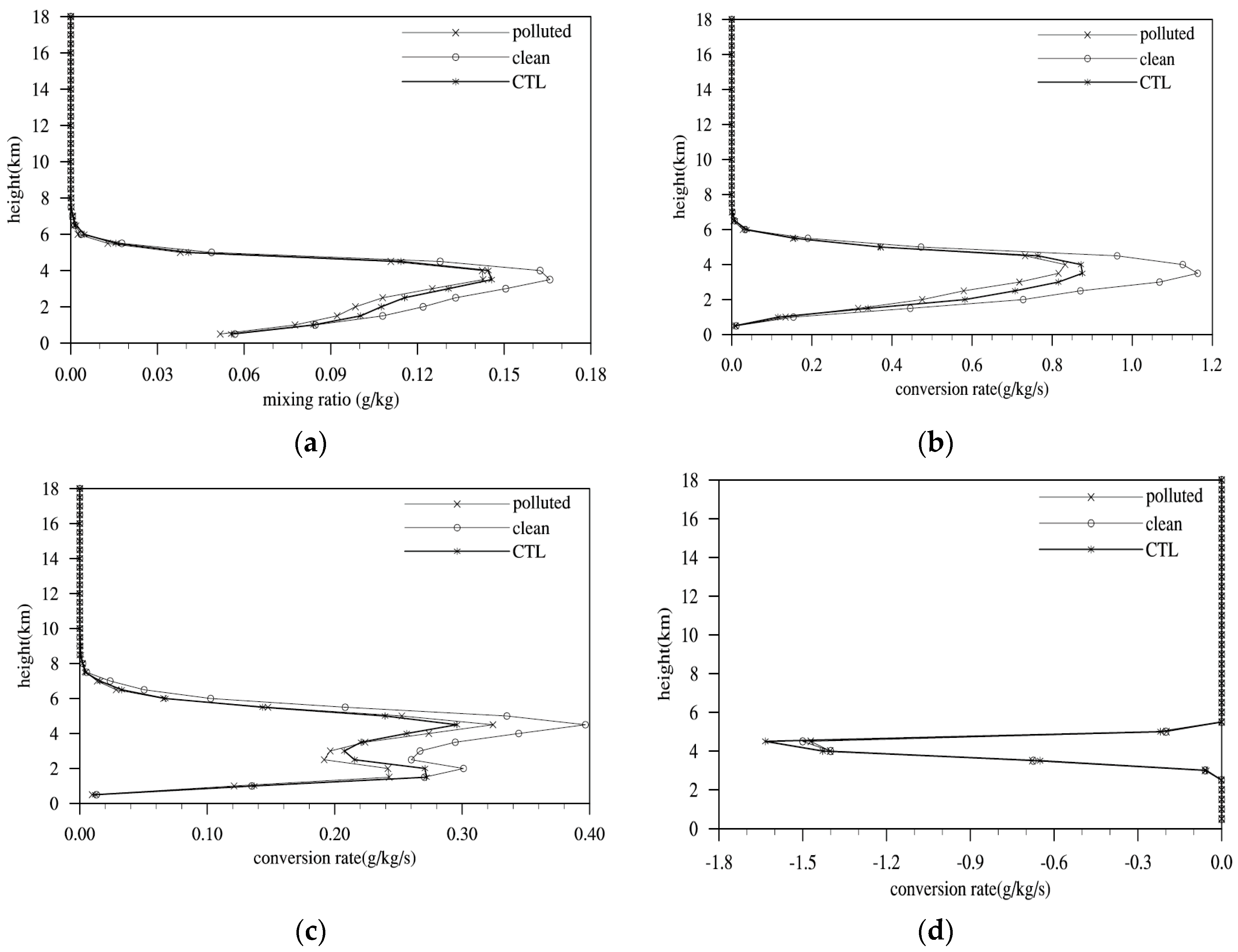

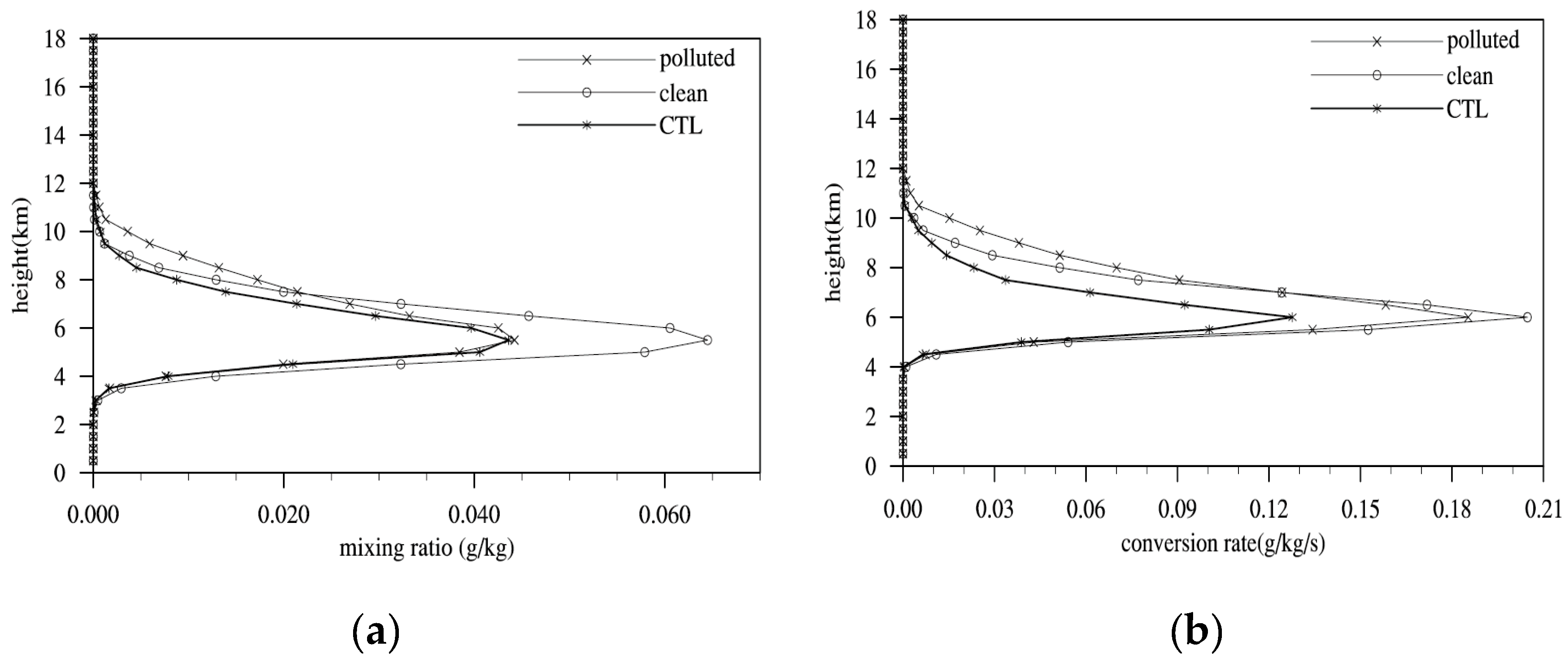
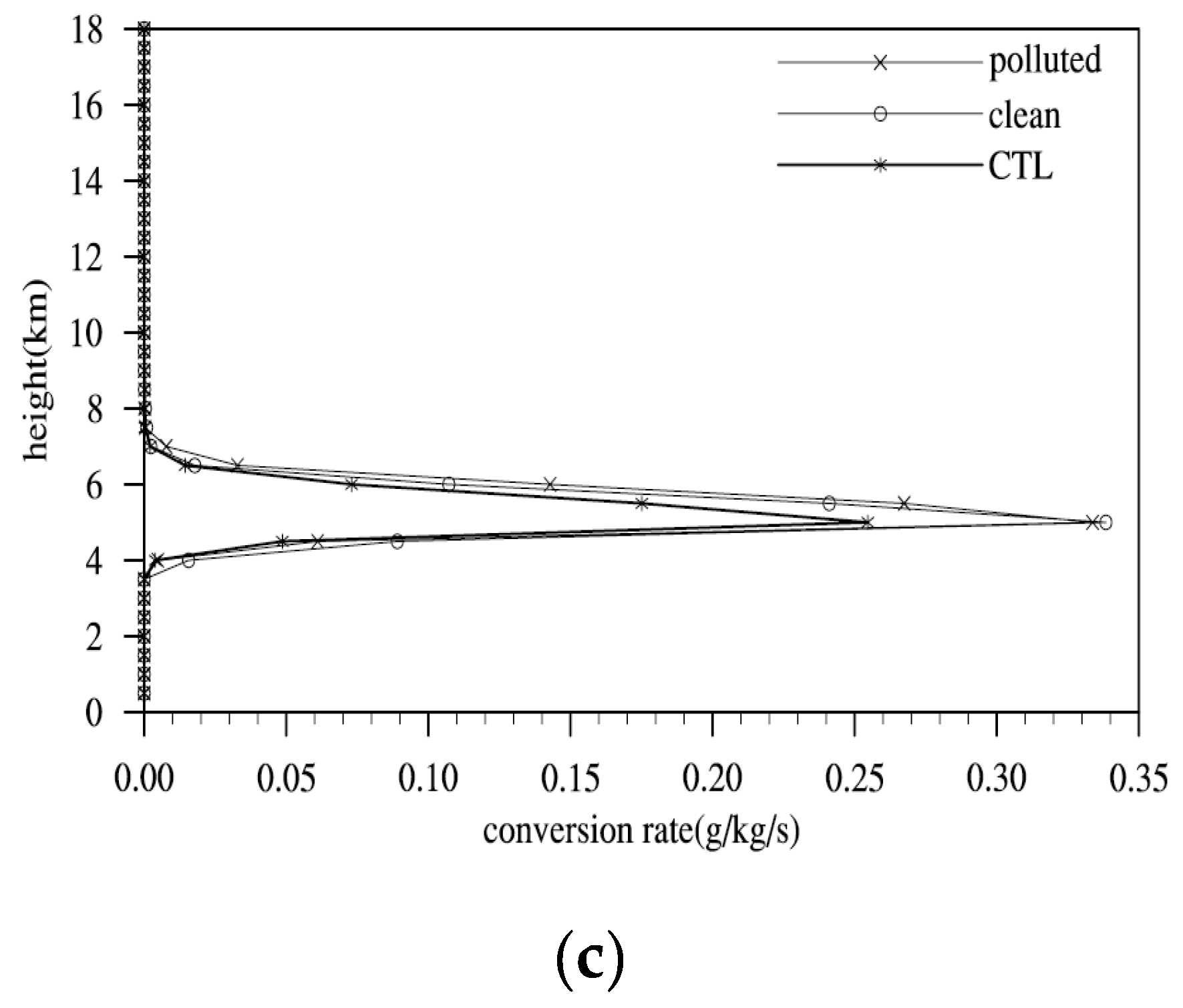
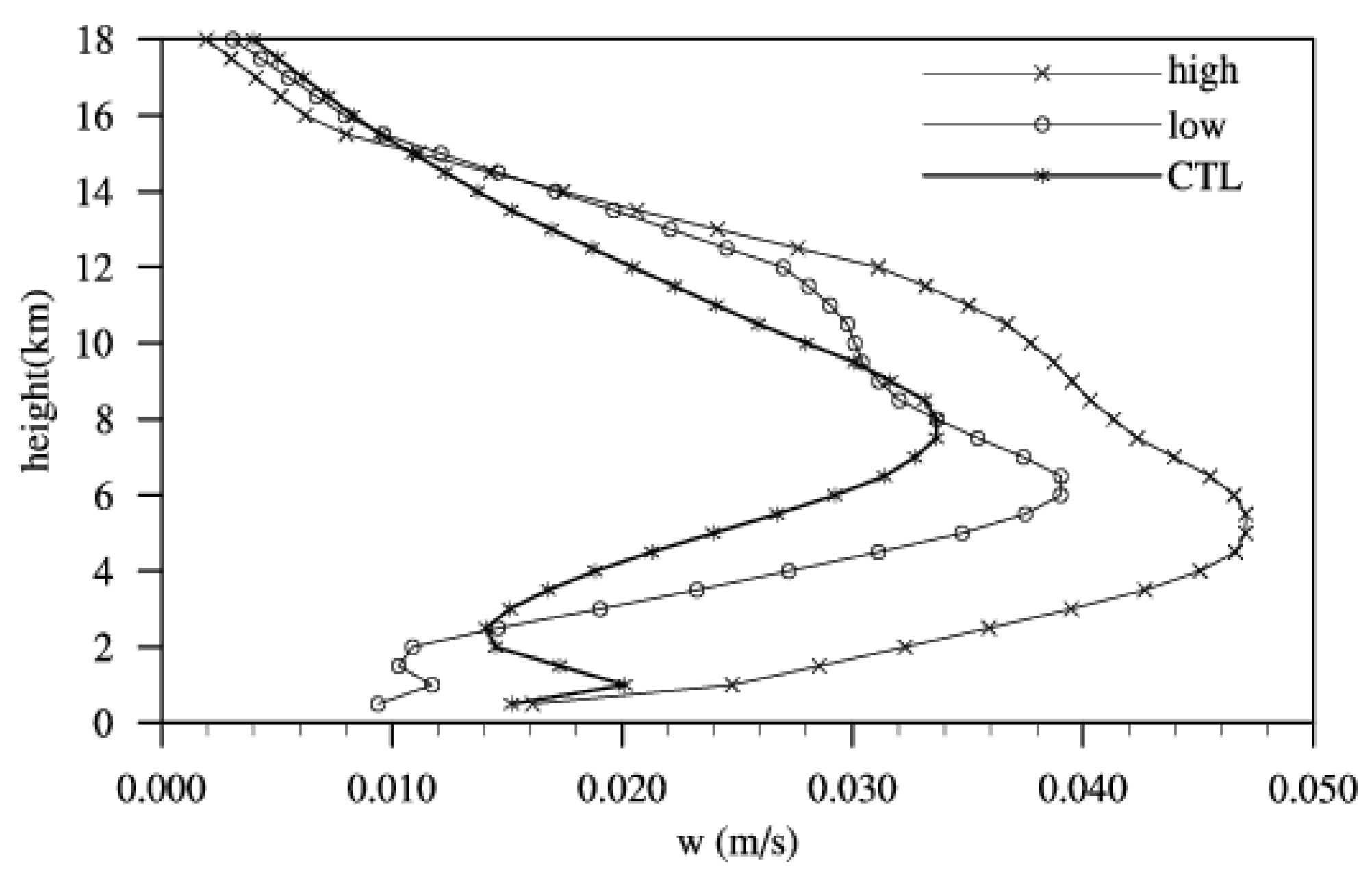
| Physical and Chemical Process | Scheme |
|---|---|
| Microphysical scheme | Morrison two-moment |
| Planetary boundary layer | YSU |
| Land surface model | Unified Noah land surface scheme |
| Shortwave radiation | RRTMG |
| Long wave radiation | RRTMG |
| Chemistry | CBMZ |
| Aerosol | MOSAIC |
| Test | 0–25 mm | 25–50 mm | 50–100 mm | 100–250 mm | >250 mm |
|---|---|---|---|---|---|
| CTL | 31.2 | 17.7 | 22.1 | 23 | 6 |
| clean | 22.1 | 18.1 | 25.2 | 27.2 | 7.4 |
| polluted | 31.8 | 17.7 | 21.3 | 23.6 | 5.6 |
© 2019 by the authors. Licensee MDPI, Basel, Switzerland. This article is an open access article distributed under the terms and conditions of the Creative Commons Attribution (CC BY) license (http://creativecommons.org/licenses/by/4.0/).
Share and Cite
Guo, C.; Xiao, H.; Yang, H.; Wen, W. Effects of Anthropogenic Aerosols on a Heavy Rainstorm in Beijing. Atmosphere 2019, 10, 162. https://doi.org/10.3390/atmos10040162
Guo C, Xiao H, Yang H, Wen W. Effects of Anthropogenic Aerosols on a Heavy Rainstorm in Beijing. Atmosphere. 2019; 10(4):162. https://doi.org/10.3390/atmos10040162
Chicago/Turabian StyleGuo, Chunwei, Hui Xiao, Huiling Yang, and Wei Wen. 2019. "Effects of Anthropogenic Aerosols on a Heavy Rainstorm in Beijing" Atmosphere 10, no. 4: 162. https://doi.org/10.3390/atmos10040162
APA StyleGuo, C., Xiao, H., Yang, H., & Wen, W. (2019). Effects of Anthropogenic Aerosols on a Heavy Rainstorm in Beijing. Atmosphere, 10(4), 162. https://doi.org/10.3390/atmos10040162




